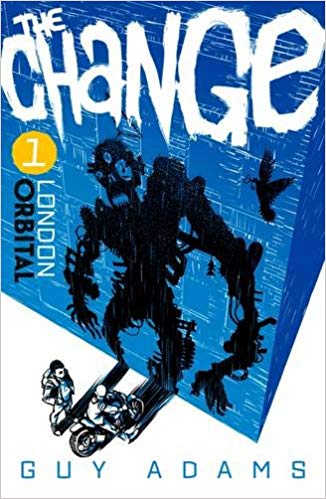-
A Halloween Happening
Adams
Hardcover (Atheneum Books for Young Readers, Oct. 1, 1981)A group of children are invited to a real witches' Halloween celebration.A very special Halloween party given by a group of witches enchants children with a pumpkin tower with a take-off and landing platform for bat-wing gliders J
J
-
The Change 1: London: Orbital
Guy Adams
eBook (Solaris, July 13, 2017)WHERE WERE YOU WHEN THE WORLD CHANGED?One minute everything was fine and the next… they arrived. Those that saw them died instantly. The unlucky ones survived. Now unimaginable things straight out of nightmares roam the streets of our towns and cities. Nothing is impossible. Nowhere is safe. And no one can escape The Change…
-
The Change 2: New York: The Queen of Coney Island
Guy Adams
eBook (Solaris, July 13, 2017)WHERE WERE YOU WHEN THE WORLD CHANGED?Grace just wants to find her brother, but she can’t go anywhere without the Queen of Coney Island’s permission to travel.Now the Queen demands payment and Grace and her new friend, a man in a false beard who believes he is God, must journey into the nightmare world of Dreamland, a tourist park whose attractions are as lethal as they are bizarre.
-
The Curse of the Werewolf: An Investigation into the Truth Behind the Legend
Guy Adams
Hardcover (Carlton Books, Aug. 2, 2011)The Curse of the Werewolf investigatates the fascinating world of lycanthropy. Told through the compelling fictional story of journalist Glendon Pierce, who believes he is becoming a werewolf, it features all of the key werewolf myths throughout history, including Native American Skinwalkers, French legends, and the Louisiana Rougarou. Presented as a beautifully illustrated scrapbook of Pierce's investigations, this volume also contains 15 removable documents covering all aspects of werewolf lore.
-
The nouveau roman and Writing in Britain After Modernism
Adam Guy
Hardcover (Oxford University Press, Feb. 5, 2020)The nouveau roman and Writing in Britain After Modernism recovers a neglected literary history. In the late 1950s, news began to arrive in Britain of a group of French writers who were remaking the form of the novel. In the work of Michel Butor, Marguerite Duras, Robert Pinget, Alain Robbe-Grillet, Nathalie Sarraute, and Claude Simon, the hallmarks of novelistic writing--discernible characters, psychological depth, linear chronology--were discarded in favour of other aesthetic horizons. Transposed to Britain's highly polarized literary culture, the nouveau roman became a focal point for debates about the novel. For some, the nouveau roman represented an aberration, and a pernicious turn against the humanistic values that the novel embodied. For others, it provided a route out of the stultifying conventionality and conformism that had taken root in British letters. On both sides, one question persisted: given the innovations of interwar modernism, to what extent was the nouveau roman actually new?This book begins by drawing on publishers archives and hitherto undocumented sources from a wide range of periodicals to show how the nouveau roman was mediated to the British public. Of central importance here is the publisher Calder & Boyars, and its belief that the nouveau roman could be enjoyed by a mass public. The book then moves onto literary responses in Britain to the nouveau roman, focusing on questions of translation, realism, the end of empire, and the writing of the project. From the translations of Maria Jolas, through to the hostile responses of the circle around C. P. Snow, and onto the literary debts expressed in novels by Brian W. Aldiss, Christine Brooke-Rose, Eva Figes, B. S. Johnson, Alan Sheridan, Muriel Spark, and Denis Williams, the nouveau roman is shown to be a central concern in the postwar British literary field.
-
The Change 3: Paris: A City of Fools
Guy Adams
eBook (Solaris, July 13, 2017)WHERE WERE YOU WHEN THE WORLD CHANGED?Loïc’s friend Adrien is gone, kidnapped by the Impressionists, bizarre men made of paint who roam the Parisian catacombs.Now, if Loïc wants to see Adrien again, he must travel to the Louvre and bring him back from the lair of the strange – and deadly – Impressionists.But the paint-men are not the only threat lurking in Paris, and Loïc must face down the needle-fingered Tricoteuse, the blade-mouthed Madame Loisette, and the dark secrets that haunt the footlights of the Grand Guignol…
-
The Change 6: Tokyo: Noriko's Story
Guy Adams
language (Solaris, Oct. 5, 2017)WHERE WERE YOU WHEN THE WORLD CHANGED?HA/HA wants what’s best for you. HA/HA is your friend. HA/HA is your mother.Obey. Behave. And never, ever, run…
-
The Change 4: London: Dirt
Guy Adams
eBook (Solaris, Oct. 5, 2017)WHERE WERE YOU WHEN THE WORLD CHANGED?There’s a new drug finding favour in this Post Change world and the roots of it are growing thick and fast beneath Kew Gardens. When Howard and Hubcap fall foul of Milo Shandler and his private militia they discover that, in the end, we’re all just compost.
-
The Change 5: New York: The River That Runs Both Ways
Guy Adams
eBook (Solaris, Oct. 5, 2017)WHERE WERE YOU WHEN THE WORLD CHANGED?Grace and friends are making their way along the Hudson. It should be an easy enough journey but time – and The Change – have other ideas. U-Boats, the hooks of the Fishermen, and the horrendous Lizabeth Fforde lie just around the bend.
-
The Change 1: London - Orbital
Guy Adams
Paperback (Solaris, )None
-
The Change vol. 5: New York - The River that Runs Both Ways
Guy Adams
Paperback (Solaris, )None
-
The Change vol. 4: London - Dirt
Guy Adams
Paperback (Solaris, )None